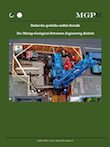Night sky brightness above Zagreb 2012.-2017.
DOI:
https://doi.org/10.17794/rgn.2018.3.9Keywords:
Light pollution, night sky brightness, site testing, atmospheric effects, ZagrebAbstract
The night sky brightness at the RGN site (near the centre of Zagreb, Croatia) was monitored form January 2012. to December 2017. The gathered data show that the average night sky brightness in this period did not change significantly, apart from differences caused by yearly variations in meteorological parameters. The nightly minima, maxima and mean values of the sky brightness do change considerably due to changes in meteorological conditions, often being between 2 and 3 magnitudes. The seasonal probability curves and histograms are constructed and are used to obtain additional information on the light pollution at the RGN site. They reveal that the night sky brightness clutters around two peaks, at about 15.0 mag/arcsec2 and at about 18.2 mag/arcsec2. The tendency to slightly lower brightness values in spring and summer can also be seen in the data. Two peaks correspond to cloudy and clear nights respectively, the difference in brightness between them being about 3 magnitudes. A crude clear/cloudy criterion can be defined too: the minimum between two peaks is around 16.7 mag/arcsec2. The brightness values smaller than thisare attributed to clear nights and vice-versa. Comparison with Vienna and Hong-Kong indicates that the light pollution of Zagreb is a few times larger.
Downloads
Published
How to Cite
Issue
Section
License
Copyright (c) 2018 Rudarsko-geološko-naftni zbornik

This work is licensed under a Creative Commons Attribution 4.0 International License.
Creative Commons-BY
Authors who publish with this journal agree to the following terms:
In agreeing this form, you certify that:
- You read the ethical codex of the RGN zbornik available at journal web.
- You submitted work is your original work, and has not previously been published and does not include any form of plagiarism.
- You own copyright in the submitted work, and are therefore permitted to assign the licence to publish to RGN zbornik.
- Your submitted work contains no violation of any existing copyright or other third party right or any material of an obscene, libellous or otherwise unlawful nature.
- You have obtained permission for and acknowledged the source of any illustrations, diagrams or other material included in the work of which you are not the copyright owner.
- You have taken due care to ensure the accuracy of the work, and that, to the best of your knowledge, there are no false statements made within it.
- All co-authors of this submitted work are aware of, and in agreement with, the terms of this licence and that the submitted manuscript has been approved by these authors.
Publication licence
You retain copyright in your submitted work, according to journal license policy (CC-BY). By signing this form you agree that RGN zbornik may publish it under the publication licence. In summary the licence allows the following:
Anyone is free:
- To copy, distribute, display, and perform the work.
- To make derivative works.
Under the following conditions:
- The original author must always be given credit.
- The work may not be used for commercial purposes.
- If the work is altered, transformed, or built upon, the resulting work may only be distributed under a licence identical to this one.
Exceptions to the licence
In addition to publishing the work printed under the above licence, RGN zbornik will also enable the work to be visible online.
The journal editorial can change the licence rules anytime but it cannot retroactively restrict author(s) rights.


